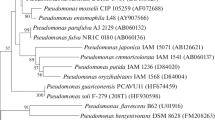Abstract
The degradation of 3,5-dichlorocatechol by enzymes of 3-chlorobenzoate-grown cells of Pseudomonas sp. strain B13 was studied. The following compounds were formed from 3,5-dichlorocatechol: trans-2-chloro-4-carboxymethylenebut-2-en-4-olide, cis-2-chloro-4-carboxymethylenebut-2-en-4-olide, and chloroacetylacrylate as the decarboxylation product of 2-chloromaleylacetate. They were identified by chromatographic and spectroscopic methods (UV, MS, PMR). An enzyme activity converting trans-2-chloro-4-carboxymethylenebut-2-en-4-olide into the cis-isomer was observed.
Similar content being viewed by others
Abbreviations
- 3CB:
-
3-chlorobenzoate
- 4CB:
-
4-chlorobenzoate
- 3,5DCB:
-
3,5-dichlorobenzoate
- 2,4D:
-
2,4-dichlorophenoxyacetate
- NOE:
-
Nuclear-Overhauser-Effect
References
Biltz H, Stepf K (1904) Über die Chlorierung des Salicylaldehyds. Ber Dt Chem Ges 37:4022–4031
Bradford MM (1976) A rapid and sensitive method for the quantitation of microgram quantities of protein utilizing the principle of protein-dye binding. Analyt Biochem 72:248–254
Chapman PJ (1979) Degradation mechanisms. In: EPA Workshop: Microbial degradation of pollutants in marine environments. EPA-600/9-79-012, 28–66
Chapman PJ, Ribbons DW (1976) Metabolism of resorcinylic compounds by bacteria: alternative pathways for resorcinol catabolism in Pseudomonas putida. J Bacteriol 125:985–998
Dakin HD (1909) The oxidation of hydroxy derivatives of benzaldehyde, acetophenone and related substances. J Am Chem Soc 42:477–498
Dorn E, Knackmuss H-J (1978) Chemical structure and biodegradability of halogenated aromatic compounds. Substituent effects of 1,2-dioxygenation of catechol. Biochem J 174:85–94
Dorn E, Hellwig M, Reineke W, Knackmuss H-J (1974) Isolation and characterization of a 3-chlorobenzoate degrading pseudomonad. Arch Microbiol 99:61–70
Duxbury JM, Tiedje JM, Alexander M, Dawson JE (1970) 2,4-D metabolism: enzymatic conversion of chloromaleylacetic acid to succinic acid. J Agric Food Chem 18:199–201
Evans WC, Smith BSW, Fernley HN, Davies JI (1971) Bacterial metabolism of 2,4-dichlorophenoxyacetate. Biochem J 122:543–551
Reineke W, Knackmuss H-J (1978) Chemical structure and biodegradability of halogenated aromatic compounds. Substituent effects on 1,2-dioxygenation of benzoic acid. Biochim Biophys Acta 542:412–423
Reineke W, Knakmuss H-J (1979) Construction of haloaromatics utilising bacteria. Nature (Lond) 277:385–386
Reineke W, Knackmuss H-J (1980) Hybrid pathway for chlorobenzoate metabolism in Pseudomonas sp. B13 derivatives. J Bacteriol 142:467–473
Reineke W, Wessels SW, Rubio MA, Latorre J, Schwien U, Schmidt E, Schlömann M, Knackmuss H-J (1982) Degradation of monochlorinated aromatics following transfer of genes encoding chlorocatechol catabolism. FEMS Microbiol Lett 14:291–294
Schmidt E, Knackmuss H-J (1980) Chemical structure and biodegradability of halogenated aromatic compounds. Conversion of chlorinated muconic acids into maleoylacetic acid. Biochem J 192:339–347
Schmidt E, Remberg G, Knackmuss H-J (1980) Chemical structure and biodegradability of halogenated aromatic compounds. Halogenated muconic acids as intermediates. Biochem J 192:331–337
Schreiber A, Hellwig M, Dorn E, Reineke W, Knackmuss H-J (1980) Critical reactions in fluorobenzoic acid degradation by Pseudomonas sp. B13. Appl Environ Microbiol 39:58–67
Sharpee RW, Duxbury JM, Alexander M (1973) 2,4-Dichlorophenoxyacetate metabolism by Arthrobacter sp.: accumulation of a chlorobutenolide. Appl Microbiol 28:181–184
Tiedje JM, Duxbury JM, Alexander M, Dawson JE (1969) 2,4-D metabolism: pathway of degradation of chlorocatechols by Arthrobacter sp. J Agric Food Chem 17:1021–1026
Author information
Authors and Affiliations
Rights and permissions
About this article
Cite this article
Schwein, U., Schmidt, E., Knackmuss, HJ. et al. Degradation of chlorosubstituted aromatic compounds by Pseudomonas sp. strain B13: fate of 3,5-dichlorocatechol. Arch. Microbiol. 150, 78–84 (1988). https://doi.org/10.1007/BF00409721
Received:
Accepted:
Issue Date:
DOI: https://doi.org/10.1007/BF00409721




